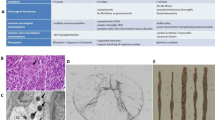Summary
A comparative analysis was made of the histological changes caused by Corynebacterium Parvum (C. parvum) injected into the brain and dermis of normal and C. parvum presensitized rats. Control rats were injected with saline. It was shown that for approximately 3 days after the intracerebral injection the brain reacted with a polymorphonuclear cell infiltration. This reaction was replaced in order by lymphocytes, macrophages, and finally by epithelioid cells progressing to granuloma. The histological changes were similar but more intense in the dermis than in the brain. Lymphocytes reached a peak by day 7, macrophages by day 3, and epithelioid cells by day 18. In comparison to the dermis, the cellular infiltration in the brain is more delayed, less intense and of longer duration. Intracerebral saline induced a moderate lymphocytic infiltrate, and in C. parvum presensitized rats a more intense macrophagic response. It is concluded that the brain of the rat, especially in the presensitized animal, mounts an inflammatory response to C. parvum which is morphologically similar to that seen in the skin.
Similar content being viewed by others
References
Albright L, Madigan JC, Gaston MR, Houchens DP (1975) Therapy in an intracerebral murine glioma model, using Bacillus Calmette-Guerin, Neuraminidase-treated tumor cells, and 1-(2-chloroethyl)-cyclohexyl-l-nitrosourea. Cancer Res 15:658–665
Albright L, Seab JA, Ommaya AD (1977) Intracerebral delayed hypersensitivity reactions in glioblastoma multiforme patients. Cancer 39:1331–1336
Bomford R (1977) An analysis of the factors allowing promotion (rather than inhibition) of tumor growth by Corynebacterium Parvum. Int J Cancer 19:673–679
Boros DL (1976) Schistosomiasis Mansoni: A granulomatous disease of cell-mediated immune etiology. Ann NY Acad Sci 278:36–46
Bubis JJ, Luse SA (1964) An electron microscopic study of experimental allergic encephalomyelitis in the rat. Am J Pathol 44:299–317
Burn CG, Finley KH (1932) The role of hypersensitivity in the production of experimental meningitis. I. Experimental meningitis in tuberculous animals. J Exp Med 56:203–221
Cravioto H, Hochwald G, Ransohoff J (1979) Delayed hypersensitivity in rat brain. Effect of C. parvum on transplantable neurogenic tumors. In: Paoletti P, Walker G, Butti G, Knerich R (eds) Multidisciplinary aspects of brain tumor therapy. Elsevier, Amsterdam, pp 35–46
Cravioto HM, De Bernardo E, Hochwald, GM, Thorbecke JG (1981) Immunity to transplantable nitrosourea-induced neurogenic tumors. I. Potentiation of tumor immunity with Corynebacterium Parvum. J Neuropathol Exp Neurol 40:526–536
Fisher B, Wolmark N, Saffer E, Fisher ER (1975) Inhibitory effect of prolonged Corynebacterium parvum and cyclophosphamide administered on the growth of established tumors. Cancer 35:134–143
Fisher B, Rubin H, Sartiano G, Ennis L, Wolmark N (1976) Observations following Corynebacterium parvum administration to patients with advanced malignancy. A Phase I study. Cancer 38:119–130
Frick E, Lamp'l F (1953) Experimentelle Untersuchungen über eine Tuberculin-Allergische Reaktion des Zentralnervensystems. Z Hyg 137:130–144
Halpern B, Biozzi G, Stiffel C, Mouton D (1966) Inhibition of tumor growth by administration of killed Corynebacterium parvum. Nature 212:853–854
Israel L, Edelstein R, Depierre A, Dimitrov N (1975) Daily intravenous infusions of Corynebacterium parvum in 20 patients with disseminated cancer. A preliminary report of clinical and biological findings. J Natl Cancer Inst 35:29–33
Jervis GA, Kaprowski N (1948) Experimental allergic encephalomyelitis. J Neuropathol Exp Neurol 7:309–320
Levine S, Wenk EJ (1965) A hyperacute form of allergic encephalomyelitis. Am J Pathol 47:61–68
Likhite VV (1976) Experimental cancer immunotherapy of tumor rejection in F-344 rats given live mycobacterium bovis (strain BCG) and killed Corynebacterium parvum. J Natl Cancer Inst 58:958–989
Ommaya AK (1976) Immunotherapy of gliomas. A review. Adv Neurol 15:337–359
Palladino MA, Thorbecke JG (1978) Immunity to transplantable carcinogen-induced fibrosarcomas in 32/B2 chickens. III. Tumor growth inhibition by local delayed hypersensitivity reactions to unrelated antigens. Eur J Immunol 8:257–262
Piessen WF, Herman R, Legros N, Hanson JC (1971) Effects of bacillus Calmette-Guerin on mammary tumor formation and cellular immunity in dimethyl-benz (a.) anthracine treated rats. Cancer Res 31:1061–1065
Pimm MV, Baldwin RW (1977) C. parvum immunotherapy of transplanted rat tumors. Int J Cancer 20:923–932
Rivers TM, Schwenkter FF (1935) Encephalomyelitis accompanied by myelin destruction experimentally produced in monkeys. J Exp Med 61:689–702
Roizin L, Kolb LC (1959) Considerations on the neuropathologic pleomorphism and histogenesis of the lesions of Experimental Allergic encephalomyelitis in non-human species. In: Kies MW, Alvord EC Jr (eds) “Allergic” encephalomyelitis. Thomas, Springfield, IL, pp 5–57
Selker RG, Wolmark N, Fisher B, Moore P (1978a) Preliminary observations on the use of Corynebacterium parvum in patients with primary intracranial tumors. Effects on intracranial pressure. J Surg Oncol 10:229–303
Selker RG, Jones E, Winkelstein A, Landey A, Iannuzzi D, Kristofik M, Closson J (1978b) Experimental evaluation of nonspecific immunostimulation and chemotherapy in the intracranial tumor-bearing Fisher rat. Dev Biol Stand 38:317–322
Steinbock P, Mahaley MS, Lipper S, Dalzell JG, Pegram C, Bigner D (1980) Failure of intracerebral BCG cell wall preparation to prevent glioma induction by avian sarcoma virus in rats. Cancer Immunol Cancer Immunother 8:55–59
Turk JL (1980) Delayed hypersensitivity, 3rd edn. Elsevier/North-Holland, Amsterdam, pp 1–295
Weisser RS, Myrnik QN, Pearsall NN (1971) Fundamentals of immunology. Delayed — type sensitivity. Lea and Febiger, Philadelphia, pp 191–204
Wisniewski HM, Bloom BR (1975) Primary demyelination as a nonspecific consequence of a cell-mediated immune reaction. J Exp Med 141:346–359
Zbar B, Tanaka T (1971) Immunotherapy of Cancer: Regression of tumors after intralesional injection of living Mycobacterium bovis. Science 172:271–273
Zbar B, Wepsic HT, Rapp NJ, Stuart LC, Borsos T (1970) Two step mechanism of tumor graft rejection in Syngeneic Guinea Pigs. II. Initiation of reaction by a cell fraction containing lymphocytes and neutrophiles. J Natl Cancer Inst 44:701–717
Author information
Authors and Affiliations
Additional information
Supported in part by The Ludwig W. Fröhlich Brain Tumor Research Fund
Rights and permissions
About this article
Cite this article
Cravioto, H.M., Hochwald, G.M. & Ransohoff, J. A study of reactions to Corynebacterium Parvum (C. parvum) in the brain and dermis of the rat. Acta Neuropathol 56, 35–44 (1982). https://doi.org/10.1007/BF00691180
Received:
Accepted:
Issue Date:
DOI: https://doi.org/10.1007/BF00691180



